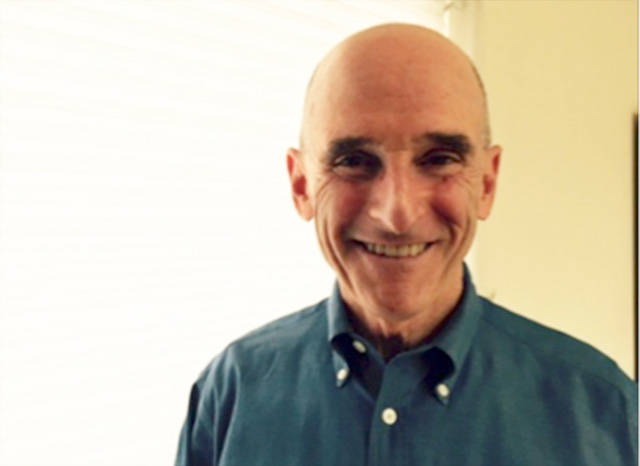If you visit a detainee at the Adelanto ICE Processing Center northeast of Los Angeles, you’ll turn off Highway 395 onto Rancho Road, travel a short distance, and pull into a parking lot squeezed between the detention facility on your left and a privately run state prison on your right.
If you’re at the east facility, you’ll walk into a small lobby, give the receptionist your ID and the detainee’s “A” number, and wait in a space decorated like a health clinic waiting room. There you’ll find cheerful nature posters, a TV set playing “Good Day LA,” a child’s play set in a corner, and Good Housekeeping magazines and a Spanish-language bible hanging on a wall.
When you’re notified that your detainee is ready to see you, you leave everything in a locker: pens, paper, keys, cellphone. You are buzzed through heavy metal doors into a visiting area, where you sit across from your detainee under the watchful eye of a guard and a TV surveillance camera. There, three or four other detainees sit as well with their family members, attorneys, or volunteer visitors. You have an hour to be with your detainee, to hear her stories, to offer whatever moral support you can, and to share a hug. Then, time is up, and your detainee, along with the three or four other women in their blue, orange, or red jumpsuits, is ushered out one door, and you through another. You look back at one another one last time.
Something seems very solid about all of this: the barbed wire outside, the heavy metal doors, the waiting room, the jumpsuits. But incongruities force their way into consciousness: The government describes this place as providing “civil, administrative confinement.” But you know it’s prison. And you wonder why your detainee, an Eritrean who simply asked for asylum when she came across the border six months ago, is imprisoned here. Or why another detainee you’ve visited, a father and hard worker who had a DUI years ago, was swept up by ICE to languish here for months.
Some facts begin to float before the mind’s eye:
• This place, the Adelanto ICE Processing Center, is a for-profit facility, run by a publicly traded corporation called the GEO Group, Inc., which made $2.26 billion in revenues from all its enterprises last year.
• Of the roughly 200 detention facilities in the U.S., almost three-fourths are run by for-profit enterprises, generating revenue from the confinement of 34,000 to 40,000 detainees per day, 400,000 per year.
• Detention facilities across the country have been cited by both governmental agencies and advocacy groups for a wide range of human rights abuses, including physical and sexual assault, medical neglect, and poor food and unsanitary conditions. Last year, the organization Human Rights Watch released a report with findings by independent medical experts that more than half the 15 deaths occurring in detention over a 16-month period (December 2015 through April 2017) were linked to inadequate medical care.
• The Adelanto ICE Processing Center didn’t even exist as an immigration detention facility until 2011, when GEO entered into an agreement with ICE (Immigration and Customs Enforcement) and the city of Adelanto to take over an existing prison. In fact, no detention facilities at all existed in the U.S. between 1954, when Ellis Island closed, and 1981, when President Ronald Reagan opened the first one in Puerto Rico to detain Haitian refugees fleeing political chaos and repression in their country.
• The 1980s and 1990s were boom years for the growth of detention facilities, their expansion intertwined with a growth of mass incarceration that scholar Michelle Alexander identified as the “New Jim Crow.” Systems of racial oppression and immigration detention have developed hand in hand; Donald Trump’s racial discourse (Mexicans as “rapists,” immigrants as “animals”) is the most recent soundtrack for these developments.
• There are proven, cost-effective alternatives to detention. These are community accompaniment programs, pioneered by organizations like Freedom for Immigrants, that respect people’s dignity and rights when they enter this country.
One day, the contractors will come back to the Adelanto ICE Processing Center. Perhaps, as they cut down the barbed wire, they will remodel the place and turn it into a school, or a museum like Ellis Island. Or, perhaps, they’ll raze the whole edifice and put up new housing units instead. Whatever the case, you’ll know as you drive away that a whole lot of work will have to be done in the meantime. This is the work of changing a mindset. This is the work of moving from opportunistic distortions (immigrants as threats and criminals) to genuine questions: How do we help others become productive, contributing members of our communities? How do we expand our understandings of our own citizenship in the process?
How do we transition from being a republic of fear to being an exemplar for other nations wrestling with issues of migration?
And how, in redefining our identities as individuals and as a nation, do we come to see the border not as a site of separation and of threats, but as a place of coming together, as a site of possibility and creativity?
Andrew Moss, syndicated by PeaceVoice, is an emeritus professor at the California State Polytechnic University, Pomona, where he taught in Nonviolence Studies for 10 years.



